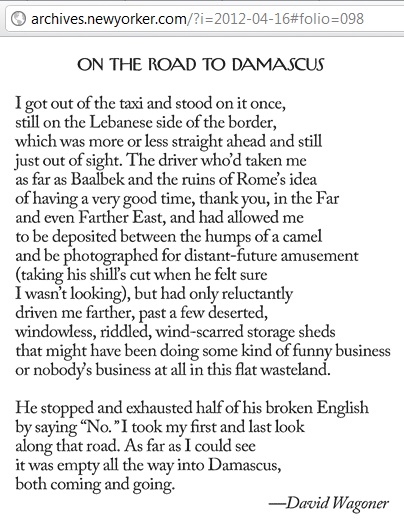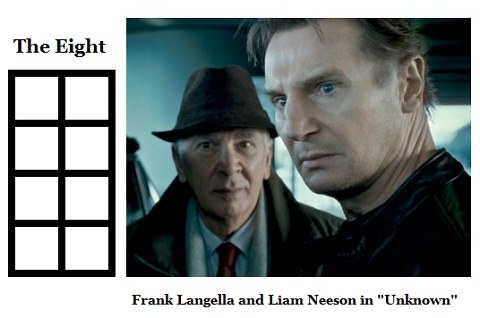Monday, April 30, 2012
(Continued from Part I and Part II.)
The paper excerpted below supplies some badly needed technical
background for the Wikipedia article on functional decomposition.

The preprint above gives the precise definitions and technical references
that are completely absent from Wikipedia's Functional decomposition.
For some related material on 4×4 arrays like those in the above figure
see Decomposition Part I and Geometry of the 4×4 Square.
Comments Off on Decomposition– Part III
Compare and contrast
1. The following excerpt from Wikipedia—

2. A webpage subtitled "Function Decomposition Over a Finite Field."
Related material—
Decomposition and Jews Telling Stories.
Comments Off on Decomposition (continued)
Sunday, April 29, 2012
“Birthday, death-day — what day is not both?”
— John Updike, The New Yorker dated August 5, 2002, page 63
Today's date— Poincaré's birth, Wittgenstein's death.
A Saint for Clark University—
Today is also the birth date of William Edward Story,
a mathematician who taught at Clark University
in Worcester, Mass.
Story's date of death was April 10, 1930.
See the Log24 posts for that date in 2012.
“Oh, Sara!” she whispered joyfully. “It is like a story!”
“It is a story,” said Sara. “Everything's a story.
You are a story— I am a story.”
— Frances Hodgson Burnett, A Little Princess
Comments Off on Story Theory
Saturday, April 28, 2012
(Continued)

An interpretation—
Posts 953 and 2341 in this journal.
Backstory— St. Patrick's Day, 2010.
Comments Off on Lottery Hermeneutics
The last paragraph of the previous post
(as updated at about 7:20 PM today)
suggests a search for the phrase
"play and interplay" that yields…
"He had accepted the world as the world,
but now he was comprehending the
organization of it, the play and interplay
of force and matter."
— Martin Eden by Jack London
This in turn suggests a review of the film "Queen to Play" —

(Background: Nabokov + Patterns.)
The review announces showings of the film at Clark University
in Worcester, Mass., on Sunday, October 30, 2011.
See also this journal on that date— "The Idea Idea"— and
references to a knight figure from today's date in 1985.
Comments Off on Play and Interplay
A Log24 post, "Bridal Birthday," one year ago today linked to
"The Discrete and the Continuous," a brief essay by David Deutsch.
From that essay—
"The idea of quantization—
the discreteness of physical quantities—
turned out to be immensely fruitful."
Deutsch's "idea of quantization" also appears in
the April 12 Log24 post Mythopoetic—
|
"Is Space Digital?"
— Cover story, Scientific American
magazine, February 2012
"The idea that space may be digital
is a fringe idea of a fringe idea
of a speculative subfield of a subfield."
— Physicist Sabine Hossenfelder
at her weblog on Feb. 5, 2012
"A quantization of space/time
is a holy grail for many theorists…."
— Peter Woit in a comment
at his weblog on April 12, 2012
|
It seems some clarification is in order.
Hossenfelder's "The idea that space may be digital"
and Woit's "a quantization of space/time" may not
refer to the same thing.
Scientific American on the concept of digital space—
"Space may not be smooth and continuous.
Instead it may be digital, composed of tiny bits."
Wikipedia on the concept of quantization—
Causal sets, loop quantum gravity, string theory,
and black hole thermodynamics all predict
a quantized spacetime….
For a purely mathematical approach to the
continuous-vs.-discrete issue, see
Finite Geometry and Physical Space.
The physics there is somewhat tongue-in-cheek,
but the geometry is serious.The issue there is not
continuous-vs.-discrete physics , but rather
Euclidean-vs.-Galois geometry .
Both sorts of geometry are of course valid.
Euclidean geometry has long been applied to
physics; Galois geometry has not. The cited
webpage describes the interplay of both sorts
of geometry— Euclidean and Galois, continuous
and discrete— within physical space— if not
within the space of physics.
Comments Off on Sprechen Sie Deutsch?
Friday, April 27, 2012
This post was suggested by Paradigms Lost
(a post cited here a year ago today),
by David Weinberger's recent essay "Shift Happens,"
and by today's opening of "The Raven."
David Weinberger in The Chronicle of Higher Education , April 22—
"… Kuhn was trying to understand how Aristotle could be such a brilliant natural scientist except when it came to understanding motion. Aristotle's idea that stones fall and fire rises because they're trying to get to their natural places seems like a simpleton's animism.
Then it became clear to Kuhn all at once. Ever since Newton, we in the West have thought movement changes an object's position in neutral space but does not change the object itself. For Aristotle, a change in position was a change in a quality of the object, and qualitative change tended toward an asymmetric actualization of potential: an acorn becomes an oak, but an oak never becomes an acorn. Motion likewise expressed a tendency for things to actualize their essence by moving to their proper place. With that, 'another initially strange part of Aristotelian doctrine begins to fall into place,' Kuhn wrote in The Road Since Structure ."
Dr. John Raven (of Raven's Progressive Matrices)—
"… these tools cannot be immediately applied within our current workplaces, educational systems, and public management systems because the operation of these systems is determined, not by personal developmental or societal needs, but by a range of latent, rarely discussed, and hard to influence sociological forces.
But this is not a cry of despair: It points to another topic which has been widely neglected by psychologists: It tells us that human behaviour is not mainly determined by internal properties— such as talents, attitudes, and values— but by external social forces. Such a transformation in psychological thinking and theorising is as great as the transformation Newton introduced into physics by noting that the movement of inanimate objects is not determined by internal, 'animistic,' properties of the objects but by invisible external forces which act upon them— invisible forces that can nevertheless be mapped, measured, and harnessed to do useful work for humankind.
So this brings us to our fourth conceptualisation and measurement topic: How are these social forces to be conceptualised, mapped, measured, and harnessed in a manner analogous to the way in which Newton made it possible to harness the destructive forces of the wind and the waves to enable sailing boats to get to their destinations?"
Before Newton, boats never arrived?
Comments Off on Paradigms Lost continues…
"These lowbrow, popular cultural references bring the possibilities
of interpretation down to an everyday level, forcing us to acknowledge
that not every painting that looks like a splatter is necessarily a
homage/anti-homage to Jackson Pollock."
— Stina Högqvist, review of the art of Josefine Lyche


Comments Off on References

The 3×3×3 Galois Cube
Backstory— The Talented, from April 26 last year,
and Atlas Shrugged, from April 27 last year.
Comments Off on An April 27–
Thursday, April 26, 2012
(Not necessarily for Rainbow People )

About the artist—
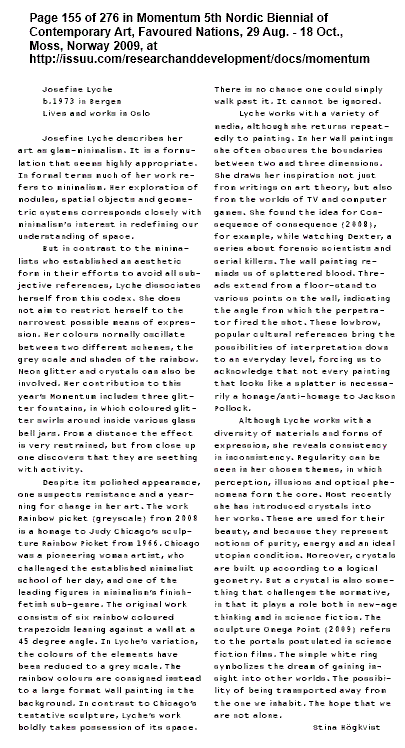
Comments Off on Rainbow Bridge for Thor’s Day
(Mythopoetic continued)
Voice of America today—
Thousands of Norwegians Defy Confessed Killer Breivik in Song
"The demonstrators waved roses and flags
Thursday as they and Norwegian folk singer
Lillebjoern Nilsen sang an adaptation
of the children's song, 'My Rainbow Race,'
which Breivik in court last week called
an example of Marxist brainwashing."
[See also PETE SEEGER AND LILLEBJØRN NILSEN.
Click on the image below for Seeger's original version.]

Liberia Reacts to Taylor Conviction With Mixed Emotions
"As the verdict was read out, a rainbow was seen
in the sky, encircling the sun. For many Liberians,
superstition is a part of life. The rainbow heralded
a new era, they said, beginning with the verdict of Taylor."
["You're not the only one… with mixed emotions."]
Comments Off on Rainbow People
Two narratives in memory of my seventh-grade
history teacher, who died on January 27, 2012—
1. On the history of Liberia
(subject of a paper I wrote in seventh grade), and
2. Comic-book history (from the above date)
Comments Off on Narratives



See also, in this journal, "The Prestige."
Comments Off on Thor’s 4/26 Light Bulb Joke
Wednesday, April 25, 2012
(Continued)
A meditation suggested by the April 20 post Complex Reflection
and by the life and April 20 death of a scientist who worked
at Los Alamos (home of the Monte Carlo method) and at
the Santa Fe Institute (home of complexity theory).

A search for 286 in this journal yields "Yet Another Cartoon Graveyard."
That June 1, 2008, post linked to poem 286 in a 1919 anthology.
Here is that poem, together with poem 823.
Together, these poems may be regarded as a meditation on
Simone Weil and her brother André Weil or,
more abstractly, on Love and Death.
Happy birthday to Al Pacino.
Comments Off on The Hallowed Crucible
(Not Olympus )
(Continued from Mythopoetic, a post of April 12)

This post was suggested by a 2010 film about fictional Olympians,
by today's New York Times obituaries, and by a bar brawl at the Olympian
New York Athletic Club in "the wee hours of April 13."
Rick Riordan in the image below advertises another large
"Demigod Gathering" on October 12, 2010.

The Riordan image is from a post at ComposersCave.com
made on October 3, 2010.
Applying Jung's principle of synchronicity to this demigod material,
we find the October 3, 2010, Log24 post Search for the Basic Picture
and the October 12, 2010, Log24 post King Solomon's Mind.
Note that the latter October date is that of the traditional
Columbus Day, and that the 2010 film of The Lightning Thief
was directed by Chris Columbus of 1492 Pictures.
The film's release was earlier in 2010, on February 12.
Comments Off on O for October
Tuesday, April 24, 2012
Comments Off on Garden Party
Suggested by a piece in the
Melbourne Herald Sun dated August 1, 2007—
A link from Log24 on that date—
Show Business
according to Fritz Leiber:
“Sid thinks you’re ready for
some of the smaller parts.”
Comments Off on Smaller Parts
Monday, April 23, 2012
In memory of Mike Wallace—
- An April 8 post noting the death of Wallace—
a NY Times obituary notice with ad at top— "The North Face"
- An April 21 post noting the death of Charles Colson,
reportedly at at 3:12 PM on Saturday, April 21, 2012,
with ad at top— "Discover New Horizons"
- An April 21 post linking to a 3/12 post (this date being
suggested by the reported time of Colson's death)
that has a review of the film "The Ninth Configuration"
- An April 22 post with six lines that some might
interpret as meeting on a horizon, two lines that might
be interpreted as meeting at a "depth horizon," and
a ninth line that emerges from the other eight
- An April 23 post that combines a passage from
"The Ninth Configuration" with a detail from
the North Face ad that appeared above Wallace's
NY TImes obituary on April 8 and again above
Colson's obituary on April 23
- "The game's…"
See also Knight Moves.
Comments Off on Mate in Six
Sunday, April 22, 2012
"… this notion of ‘depth’ is an elusive one
even for a mathematician who can recognize it…."
— G. H. Hardy, A Mathematician's Apology
In Geometry and the Imagination , Hilbert and Cohn-Vossen
describe the Brianchon-Pascal configuration of 9 points
and 9 lines, with 3 points on each line and 3 lines through
each point, as being "the most important configuration of all geometry."
The Brianchon-Pascal configuration is also known as the Pappus configuration—

Some background …
"The Theorem of Pappus: A Bridge Between Algebra and Geometry"
Elena Anne Marchisotto
The American Mathematical Monthly
Vol. 109, No. 6 (Jun. – Jul., 2002), pp. 497-516
Comments Off on An Elusive Notion

Click image for some context from MIT.
Background from The New York Times— "Can You Make Yourself Smarter?"
See also "Plan 9" in this journal.
Comments Off on Plan 9 from MIT
"Every multiplayer game, both free-for-all and team based,
will begin with a Mexican standoff." —Wikipedia

"The Cardinal seemed a little preoccupied today."
Comments Off on The Gospel According to Xbox
Saturday, April 21, 2012

In "Contact," Dr. Arroway is shown the key to the Primer—

In this journal, fictional symbologist Robert Langdon is shown a cube—

"Confusion is nothing new." — Song lyric
Comments Off on Finding a Form
"So the sundering we sense between nature and culture
lies not like a canyon outside us, but splits our being
at its most intimate depths the way mind breaks off from body.
It is still another version of that bitter bifurcation
long ago decreed— our expulsion from Eden…."
— William H. Gass in Finding a Form ,
Cornell U. Press paperback, 1997, page 138
See also…

For another bitter bifurcation, see La Despedida .
Comments Off on Split
Comments Off on Meanwhile…
— Title of a 1975 film. The late Martin Poll (previous post)
was the executive producer.
See also "A Corpse Will Be Transported by Express."
Related material—

Comments Off on Love and Death–
From Deadline Hollywood—
A film producer's death "between Friday night and early Saturday morning,"
April 13-14, 2012—
| R.I.P. Martin Poll
By THE DEADLINE TEAM | Sunday April 15, 2012 @ 7:36 pm PDT
Veteran movie and TV producer Martin Poll died between Friday night and early Saturday morning of natural causes at a care facility on the Upper Westside in New York City. He was 89.
|
See also the post linked to on the afternoon of Friday the 13th of April—
"All the saints have powers." — Cardinal Marchisano.
Happy birthday, James McAvoy (at left below in X-Men: First Class ).

Comments Off on But Seriously…
(Continued from October First, 2010)

Estas son las mañanitas….
Today's Birthdays:
Britain's Queen Elizabeth II is 86.
Actress-comedian-writer Elaine May is 80.
Actor Charles Grodin is 77.
— AP, Today in History, April 21, 2012
Comments Off on Volcano Dawn
Friday, April 20, 2012
Found in a Google search today—
(Click image for videos.)

I hadn't known until today that youtube.com/blogs/m759 exists.
The Arduino link under "More Channels" suggests a site
that may interest some future Arroway or Hadden.
Comments Off on Uploading Levon
Yesterday's post in memory of Octavio Paz—
An earlier post yesterday, Fashion Notes, linked to a Sting video—

|
From "Loo Ree," by Zenna Henderson
"It's so hard to explain–"
"Oh, foof!" I cried defiantly, taking off my glasses and, smearing the tears across both lenses with a tattered Kleenex. "So I'm a dope, a moron! If I can explain protective coloration to my six-year-olds and the interdependence of man and animals, you can tell me something of what the score is!" I scrubbed the back of my hand across my blurry eyes. "If you have to, start out 'Once upon a time."' I sat down– hard.
Loo Ree smiled and sat down, too. "Don't cry, teacher. Teachers aren't supposed to have tears."
"I know it," I sniffed. "A little less than human-that's us."
"A little more than human, sometimes." Loo Ree corrected gently. "Well then, you must understand that I'll have to simplify. You will have to dress the bare bones of the explanation according to your capabilities.
"Once upon a time there was a classroom. Oh, cosmic in size, but so like yours that you would smile in recognition if you could see it all. And somewhere in the classroom something was wrong. Not the whispering and murmuring– that's usual. Not the pinching and poking and tattling that goes on until you get so you don't even hear it." I nodded. How well I knew.
"It wasn't even the sudden blow across the aisle or the unexpected wrestling match in the back of the room. That happens often, too. But something else was wrong. It was an undercurrent, a stealthy, sly sort of thing that has to be caught early or it disrupts the whole classroom and tarnishes the children with a darkness that will never quite rub off.
"The teacher could feel it –as all good teachers can– and she spoke to the principal. He, being a good principal, immediately saw the urgency of the matter and also saw that it was beyond him, so he called in an Expert." "You?" I asked, feeling quite bright because I had followed the analogy so far.
Loo Ree smiled. "Well, I'm part of the Expert."
|
"If you have to, start out 'Once upon a time.'"
Yesterday's Paz post was at 6:48 PM EDT.
For the autistic, here is some related mathematics.
Yesterday's Fashion Notes post was at 1:06 PM EDT.
A related chronological note from Rolling Stone yesterday—
"Levon Helm, singer and drummer for the Band,
died on April 19th in New York of throat cancer.
He was 71.
"He passed away peacefully at 1:30 this afternoon…."
Helm and The Band performing "The Weight"—
"I pulled into Nazareth, I was a-feelin' 'bout half past dead…"
Comments Off on Complex Reflection
Thursday, April 19, 2012
Suggested by two posts today at other weblogs—
"The Ariel Thread" and "Spring in the Virgin Islands."

Background— Beach with Palms, One Story and Descanse .
Comments Off on The Virgin’s Tale
For Octavio Paz, who died on this date in 1998
|
… the free-standing, two-sided “Life-Death Figure,”
carved from stone in Mexico some time between
A.D. 900 and 1250, has multiple personalities.
— Holland Cotter, New York Times online today
|
Comments Off on In Memoriam
The Hot Rock

See also A Little Story .
Comments Off on Under the Volcano–
Comments Off on Fashion Notes
Comments Off on Past Eve and Adam’s
Wednesday, April 18, 2012
…. and John Golding, an authority on Cubism who "courted abstraction"—

"Adam in Eden was the father of Descartes." — Wallace Stevens
Fictional symbologist Robert Langdon and a cube—

From a Log24 post, "Eightfold Cube Revisited,"
on the date of Golding's death—

A related quotation—
"… quaternions provide a useful paradigm
for studying the phenomenon of 'triality.'"
— David A. Richter's webpage Zometool Triality
See also quaternions in another Log24 post
from the date of Golding's death— Easter Act.
Comments Off on Adam in Eden
"… he continued to make brief appearances
on the show, including the one this past
New Year's Eve.* "
— Bruce Weber, New York Times
"The only stars Clark coveted
for his show in those early years
but could not get were
the Beatles and Ricky Nelson…."
— Geoff Boucher, Los Angeles Times
"I don't know why you say goodbye"
"There was … magic in the air"
* The link is to another eve, Bridget's .
Comments Off on Eve in the Garden
Tuesday, April 17, 2012
Comments Off on Space Speech
Monday, April 16, 2012
F.A. Porsche:
„Ein formal stimmiges Produkt braucht keine Verzierung,
es soll durch die reine Form erhöht werden.“
"My friends all drive Porsches,
I must make amends."
— Janis Joplin, Pearl Sessions CD
reissue released today at Amazon.co.uk
Comments Off on Happy Birthday, Benedict XVI
Gary Gutting, "Arguing About Language," in "The Stone,"
The New York Times philosophy column, yesterday—
There's a sense in which we speak language
and a sense in which, in Mallarmé's famous phrase,
“language itself speaks.”
Famous? A Google Book Search for
"language itself speaks" Mallarmé
yields 2 results, neither helpful.
But a Google Book Search for
"language itself speaks" Heidegger
yields "about 312 results."
A related search yields the following—
Paul Valéry, encountering Un Coup de Dés in Mallarmé’s worksheets in 1897, described the text as tracing the pattern of thought itself:
It seemed to me that I was looking at the form and pattern of a thought, placed for the first time in finite space. Here space itself truly spoke, dreamed, and gave birth to temporal forms….
… there in the same void with them, like some new form of matter arranged in systems or masses or trailing lines, coexisted the Word! (Leonardo 309*)
* The page number is apparently a reference to The Collected Works of Paul Valéry: Leonardo, Poe, Mallarmé , translated by Malcolm Cowley and James R. Lawler, Princeton University Press, 1972. (As a temporal form, "309" might be interpreted as a reference to 3/09, March 9, the date of a webpage on the Void.)
For example—

Background:
Deconstructing Alice
and Symbology.
Comments Off on Carroll Thanks the Academy
Sunday, April 15, 2012
This afternoon's post Tally quotes "Day-O,"
a song performed, notably, in the 1988 film
"Beetlejuice"—
More merriment —
Tummler Lou Goldstein died at 90 on April 2, 2012,
according to this evening's online New York Times .
In his honor, figures from a Sept. 17, 2009, post—
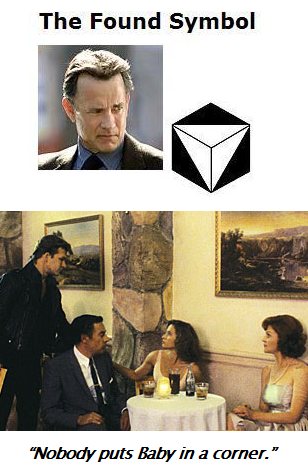
See also "Boo Boo Boo."
Those not amused by tummler humor may prefer
a post from the date of Goldstein's death
related to the object viewed above by the fictional
symbologist Robert Langdon.
Comments Off on Ghost Humor
Comments Off on Fun and Games
Comments Off on Irish Geometry
Saturday, April 14, 2012
Two papers suggested by Google searches tonight—
Curtis discusses the exceptional outer automorphism of S6
as arising from group actions of PGL(2,5).
See also Cameron and Galois on PGL(2,5)—
citeseerx.ist.psu.edu/viewdoc/download?doi=10.1.1.104…
You +1'd this publicly. Undo
File Format: PDF/Adobe Acrobat – Quick View
by PJ CAMERON – 1975 – Cited by 14 – Related articles
PETER J. CAMERON. It is known that, if G is a triply transitive permutation group
on a finite set X with a regular … S3 the symmetric group on 3 letters, and PGL (2, 5)
the 2-dimensional projective general linear … Received 24 October, 1973
|
Illustration from Cameron (1973)—

Comments Off on Scottish Algebra
Friday, April 13, 2012
Comments Off on Meditation for Friday the 13th
The two previous posts have referred to the HBO series "Big Love."
For a more constructive production related to a Latter-Day Saint,
see the video of the 1989 song "Sacred Emotion."
The visually impaired may be forgiven for thinking
the voice in the video is that of Michael Jackson.
"Our love is like a sacred emotion." — Donny Osmond
Comments Off on Constructive
Comments Off on Putting the Prime in “Primate”

From the day Askew died—
The "large and startling" phrase is from Flannery O'Connor—
|
From Georgia College, Milledgeville, GA—
… in Flannery O'Connor's essay "The Fiction Writer and His Country"… she explains why she writes the way she does: "When you can assume that your audience holds the same beliefs you do, you can relax a little and use more normal means of talking to it; when you have to assume that it does not, then you have to make your vision apparent by shock— to the hard of hearing you shout, and for the almost-blind you draw large and startling figures" (Mystery and Manners , p. 34).
|
For a large and startling figure played by Askew, see a scene from "Big Love."

Comments Off on Askew Crews
George Steiner —
"Man is, in Lévi-Strauss's view, a mythopoetic primate
(it's a difficult phrase but we don't have a better one)…."
Wikipedia —
"Primate is a title or rank bestowed on some bishops in certain Christian churches."
Pope Benedict XVI at the 2012 Easter Vigil on April 7 —
"The great hymn of the Exsultet, which the deacon sings at the beginning of the Easter liturgy, points us quite gently towards a further aspect. It reminds us that this object, the candle, has its origin in the work of bees. So the whole of creation plays its part. In the candle, creation becomes a bearer of light.
But in the mind of the Fathers, the candle also in some sense contains a silent reference to the Church. The cooperation of the living community of believers in the Church in some way resembles the activity of bees. It builds up the community of light."
http://twitter.com/#!/skdh —

Comments Off on The Primate and the Bee
Thursday, April 12, 2012
"Is Space Digital?"
— Cover story, Scientific American magazine, February 2012
"The idea that space may be digital
is a fringe idea of a fringe idea
of a speculative subfield of a subfield."
— Physicist Sabine Hossenfelder
at her weblog on Feb. 5, 2012
"A quantization of space/time
is a holy grail for many theorists…."
— Peter Woit in a comment at his physics weblog today
See also
* See yesterday's Steiner's Systems.
Comments Off on Mythopoetic*
Comments Off on Classroom
Wednesday, April 11, 2012
Background— George Steiner in this journal
and elsewhere—
"An intensity of outward attention —
interest, curiosity, healthy obsession —
was Steiner’s version of God’s grace."
— Lee Siegel in The New York Times ,
March 12, 2009
(See also Aesthetics of Matter in this journal on that date.)
Steiner in 1969 defined man as "a language animal."
Here is Steiner in 1974 on another definition—

Related material—

Also related — Kantor in 1981 on "exquisite finite geometries," and The Galois Tesseract.
Comments Off on Steiner’s Systems
Tuesday, April 10, 2012
|
Edward Reed Whittemore Jr. was born
on Sept. 11, 1919, in New Haven,
where his father was a doctor.
He earned a bachelor’s degree in English from Yale.
As a sophomore there, with his roommate
James Jesus Angleton (who would later become
the Central Intelligence Agency’s counterintelligence chief),
he founded a literary magazine, Furioso.
— The New York Times
|
In memoriam:
PART I —

PART II —
- Computers in "23"
- Der Einsatz
- The Borges Compass
Comments Off on Death on Good Friday
Where Entertainment is God
(Continued from April 4 and April 8)

"Hot dog… I'm a winner either way."
— Mary Chapin Carpenter
Comments Off on Carpenter Song…
Today's Times teasers—

Location, Location, Location.
Click on image for further details.
See also April 3rd's Catholic View.
Comments Off on The Christening

See also Argyle in this journal.
Comments Off on Cameo
"A New York Jew imitates D. H. Lawrence at his peril."
The New York Times today—
“Our focus is on creating very high quality, highly artistically produced programs that bring together worlds that usually don’t talk to each other,” said Dr. Greene, a physics and math professor at Columbia and well-known popularizer of science. “We’ve tried to inject the drama of science into these highly produced programs, so people leave the event saying, ‘Wow, I didn’t know that’s what science is like.’ ”
As for D. H. Lawrence, see this journal on September 10, 2003.
* For the title, see last night's Turing Gate.
Comments Off on Dehors*
Comments Off on Turing Gate
Monday, April 9, 2012
A search today (Élie Cartan's birthday) for material related to triality*

yielded references to something that has been called a Bhargava cube .
Two pages from a 2006 paper by Bhargava—


Bhargava's reference [4] above for "the story of the cube" is to…
Higher Composition Laws I:
A New View on Gauss Composition,
and Quadratic Generalizations
Manjul Bhargava
The Annals of Mathematics
Second Series, Vol. 159, No. 1 (Jan., 2004), pp. 217-250
Published by: Annals of Mathematics
Article Stable URL: http://www.jstor.org/stable/3597249
A brief account in the context of embedding problems (click to enlarge)—

For more ways of slicing a cube,
see The Eightfold Cube —

* Note (1) some remarks by Tony Smith
related to the above Dynkin diagram
and (2) another colorful variation on the diagram.
Comments Off on Eightfold Cube Revisited
Acts 12:4 —
"And when he had apprehended him,
he put him in prison, and delivered him
to four quaternions of soldiers to keep him;
intending after Easter to bring him forth to the people."
With six you get egg roll.
Comments Off on Easter Act
Sunday, April 8, 2012
Comments Off on Time Goes By
For Autism Awareness Month—
See George Steiner on Autistic Enchantment, as well as…
(Click images for further details.)


This year, Autism Awareness Day was April 2.
Comments Off on Steiner System
Click to enlarge.


See also March 9, 2007 and the film Queen to Play (NY-LA release: 2011, April 1).
The U.S. premiere of Queen to Play was on April 25, 2009 at the Tribeca Festival.
"Now, I'll open up a line of credit for you.
You'll be wantin' a few toys."
— A Robert De Niro character quoted in
Lines (St. Andrew's Day, 2011)
Update of 10:10 AM EDT April 8 (Easter Day)—
See an "old Brooklyn haunt" in The Easter Phantom.
Comments Off on The Two Towers
Saturday, April 7, 2012
… On Holy Saturday
"'If only they could send us something grown-up… a sign or something.'
And a sign does come from the outside. That night, unknown to the children,
a plane is shot down and its pilot parachutes dead to earth and is caught
in the rocks on the mountain. It requires no more than the darkness of night
together with the shadows of the forest vibrating in the signal fire to distort
the tangled corpse with its expanding silk 'chute into a demon that must
be appeased."
— Claire Rosenfield, 1961 essay about Lord of the Flies
A Flies-related death from April 1—
Edmund L. Epstein, Scholar Who Saved ‘Lord of the Flies,’ Dies at 80
See also Holy Saturday, 2004.
Comments Off on Appeasing Epstein
Comments Off on Requiem for Kinkade
Comments Off on Foreground
From Joyce's 1912 Trieste lecture on Blake:
"Michelangelo's influence is felt in all of Blake's work, and especially in some passages of prose collected in the fragments, in which he always insists on the importance of the pure, clean line that evokes and creates the figure on the background of the uncreated void."
For a related thought from Michelangelo, see Marmo Solo .
For pure, clean lines, see Galois Geometry.
As for "the uncreated void," see the Ernst Gombrich link in Marmo Solo for "an almost medieval allegory of how man confronts the void."
For some related religious remarks suited to the Harrowing of Hell on this Holy Saturday, see August 16, 2003.
Comments Off on Background
(Continued from March 10, 2012)
An inaccuracy in a passage linked to yesterday—
“The created universe, the whole of things, is,
in words from Joyce’s Ulysses , ‘predicated on the void.'”
The “predicated” phrase seems to be absent from Ulysses .
Joyce does, however, have the following (from ricorso.net)—
| “William Blake” (March 1912) – cont.: ‘Armed with this two-edged sword, the art of Michaelangelo and the revelations of Swedenborg, Blake killed the dragon of experience and natural wisdom, and, by minimising space and time and denying the existence of memory and the senses, he tried to paint his works on the void of the divine bosom. [See note, infra.]To him, each moment shorter than a pulse-beat was equivalent in its duration to six thousand years, because in such an infinitely short instant the work of the poet is conceived and born. To him, all space larger than a red globule of human blood was visionary, created by the hammer of Los, while in a space smaller than a globule of blood we approach eternity, of which our vegetable world is but a shadow. Not with the eye, then, but beyond the eye, the soul and the supreme move must look, because the eye, which was born in the night while the soul was sleeping in rays of light, will also die in the night. […] The mental process by which Blake arrives at the threshold of the infinite is a similar process. Flying from the infinitely small to the infinitely large, from a drop of blood to the universe of stars, his soul is consumed by the rapidity of flight, and finds itself renewed and winged and immortal on the edge of th dark ocean of God. And althought he based his art on such idealist premises, convinced that eternity was in love with the products of time, this sons of God with the sons of [MS ends here].’ (Critical Writings, 1959, 1966 Edn., pp.221-22; quoted [in part] in Richard Ellmann, James Joyce, 1965 Edn., p.330.) [For full text, see RICORSO Library, “Major Authors”, via index, or direct.] Note – for “void” [supra] , cf. Stephen in “Scylla & Charybdis”: ‘Fatherhood […] is a mystical estate, an apostolic succession, from only begetter to only begotten. On that mystery and not on the madonna which the cunning Italian intellect flung to the mob of Europe the church is founded and founded irremovably because founded, like the world, macro- and microcosm, upon the void.’ (Ulysses, Penguin Edn. 1967, p.207; [my itals.].) |
Some academics may prefer a more leftist version of
“predicated on the void”—

Comments Off on The Void
For St. Dismas, a Holy Saturday story—
"Mr. Rosensaft told another story to illustrate his friend's mix of grit and wit. Mr. Steinberg was negotiating one day with the French culture minister to recover paintings stolen from Jews during the Holocaust. The minister huffed that Mr. Steinberg knew nothing about art.
'You're right,' Mr. Steinberg said. 'I don't know anything about art. I'm from Brooklyn. I know about stolen goods.'"
— New York Times this morning
See also yesterday afternoon's Good Friday post
and the passage on Aquinas that it links to.
Comments Off on Knowing Brooklyn
Friday, April 6, 2012
From St. Dismas, a link: http://www.scribd.com/doc/62700189/9/nine *
And in this journal… "Nine is a Vine."
* Aquinas, Ethics, and Philosophy of Religion:
Metaphysics and Practice , by Thomas Hibbs,
Indiana University Press, Bloomington and Indianapolis, 2007
Comments Off on For Good Friday
F.A. Porsche:
„Ein formal stimmiges Produkt braucht keine Verzierung,
es soll durch die reine Form erhöht werden.“
Comments Off on Reine Form
Comments Off on Spectral Theory
Thursday, April 5, 2012
From Katherine Neville's novel The Eight (see also April 4, Der Einsatz )—


"You walked out of my dreams and into my car…"
* Frost
Comments Off on Go Ask Emma*
An image from 62 years ago:

Click image for details.
For the religious significance of "62," see Strong Emergence Illustrated.
See also a related search.
Comments Off on In the Details
Comments Off on Meanwhile, back in 1950…
Presidential candidate Mitt Romney on Monday, April 2, 2012—
"I think there is in this country a war on religion.
I think there is a desire to establish a religion
in America known as secularism."
Nancy Haught of The Oregonian on Leap Day, Feb. 29, 2012—

|
William Hamilton, the retired theologian who declared in the 1960s that God was dead, died Tuesday [Feb. 28, 2012] in his downtown Portland apartment at 87. Hamilton said he'd been haunted by questions about God since he was a teenager. Years later, when his conclusion was published in the April 8, 1966, edition of Time Magazine, he found himself in a hornet's nest.
Time christened the new movement "radical theology" and Hamilton, one of its key figures, received death threats and inspired angry letters to the editor in newspapers that carried the story. He encountered hostility at Colgate Rochester Crozer Divinity School, where he had been teaching theology, and lost his endowed chair in 1967.
Hamilton moved on to teach religion at New College in Sarasota, Fla.
|
(See also this journal on Leap Day.)
From New College: The Honors College of Florida—
|
History Highlights
Oct. 11, 1960: New College is founded as a private college
1961: Trustees obtain options to purchase the former Charles Ringling estate on Sarasota Bay and 12 acres of airport land facing U.S. 41 held by private interests. The two pieces form the heart of the campus
Nov. 18, 1962: the campus is dedicated. Earth from Harvard is mixed with soil from New College as a symbol of the shared lofty ideals of the two institutions.
|
See also, in this journal, "Greatest Show on Earth" and The Harvard Crimson—
The Harvard Crimson,
Online Edition |
Sunday,
Oct. 8, 2006 |
|
POMP AND
CIRCUS-STANCE

CRIMSON/ MEGHAN T. PURDY
Friday, Oct. 6:
The Ringling Bros. Barnum & Bailey Circus has come to town, and yesterday the animals were disembarked near MIT and paraded to their temporary home at the Banknorth Garden.
|
OPINION
At Last, a
Guiding Philosophy
The General Education report is a strong cornerstone, though further scrutiny is required.
By THE CRIMSON STAFF
After four long years, the Curricular Review has finally found its heart.
The Trouble
With the Germans
The College is a little under-educated these days.
By SAHIL K. MAHTANI
Harvard College– in the best formulation I’ve heard– promulgates a Japanese-style education, where the professoriate pretend to teach, the students pretend to learn, and everyone is happy.
|
Comments Off on Leap Day of Faith
Wednesday, April 4, 2012
I said, "Look out, boys, I've got a license to fly"
And that Caddy pulled over and let us by
Followup story to this morning's Easter Prayer Breakfast—
Why Walk?
Comments Off on Carpenter Song
Comments Off on Finishing School
Continues…
|

”Confusion is nothing new.”
– Song lyric, Cyndi Lauper
|
(This may serve as today’s tribute to Katherine Neville.)
Comments Off on Der Einsatz
Comments Off on Death Proof
Meanwhile, back in June 2004—
The Marilyn Monroe Rose and JFK …

… meet The Crimson Spectre —

(Suggested by this morning's
New York Times obituaries—
"A spectre is haunting…"— Karl Marx)
Comments Off on SPECTRE
Tuesday, April 3, 2012
Monday in Cuernavaca—

… and in Cambridge—

* See the Latin version in this journal.
Comments Off on Community*
"When shall we three meet again?"

Left to right— John von Neumann, Richard Feynman, Stanislaw Ulam
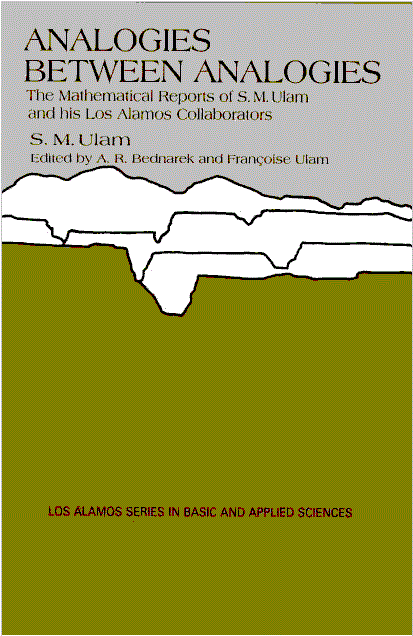
The source of the above book's title, "Analogies between Analogies,"
was misattributed in a weblog post linked to here on March 4th, 2012.
It occurs in a quote due not to Stanislaw Ulam but to Stefan Banach—

Ulam was Jewish. Banach was not.
From a webpage on Banach—
"On 3 April 1892, he was baptized in the Roman Catholic
Parish of St. Nicholas in Krakow."
See also…
- a post of Sunday, April 2, 2006,
- yesterday's Pennsylvania lottery, and
- post 585 in this journal.
(At Los Alamos, Ulam developed the Monte Carlo method.)
Comments Off on Catholic View
Monday, April 2, 2012
This journal on June 18, 2008—

The Wechsler Cubes story continues with a paper from December 2009…
"Learning effects were assessed for the block design (BD) task,
on the basis of variation in 2 stimulus parameters:
perceptual cohesiveness (PC) and set size uncertainty (U)." —

(Click image for some background.)
The real intelligence test is, of course, the one Wechsler flunked—
investigating the properties of designs made with sixteen
of his cubes instead of nine.
Comments Off on Intelligence Test
See a search for the title in this journal.
See also Stories about Nine.
Comments Off on Nine Stories
Suggested by the post for Christmas 2010—

Comments Off on Group Actions
The Hallowed Crucible continues…

From today's New York Times , page B8 of the New York edition—

Comments Off on A Saint for Patrick —
Sunday, April 1, 2012
A physics quote relayed at Peter Woit's weblog today—
"The relation between 4D N=4 SYM and the 6D (2, 0) theory
is just like that between Darth Vader and the Emperor.
You see Darth Vader and you think 'Isn’t he just great?
How can anyone be greater than that? No way.'
Then you meet the Emperor."
— Arkani-Hamed
Some related material from this weblog—
(See Big Apple and Columbia Film Theory)

The Meno Embedding:

Some related material from the Web—

See also uses of the word triality in mathematics. For instance…
A discussion of triality by Edward Witten—
Triality is in some sense the last of the exceptional isomorphisms,
and the role of triality for n = 6 thus makes it plausible that n = 6
is the maximum dimension for superconformal symmetry,
though I will not give a proof here.
— "Conformal Field Theory in Four and Six Dimensions"
and a discussion by Peter J. Cameron—
There are exactly two non-isomorphic ways
to partition the 4-subsets of a 9-set
into nine copies of AG(�3,2)�.
Both admit 2-transitive groups.
— "The Klein Quadric and Triality"
Exercise: Is Witten's triality related to Cameron's?
(For some historical background, see the triality link from above
and Cameron's Klein Correspondence and Triality.)
Cameron applies his triality to the pure geometry of a 9-set.
For a 9-set viewed in the context of physics, see A Beginning—
Happy April 1.
Comments Off on The Palpatine Dimension






















































